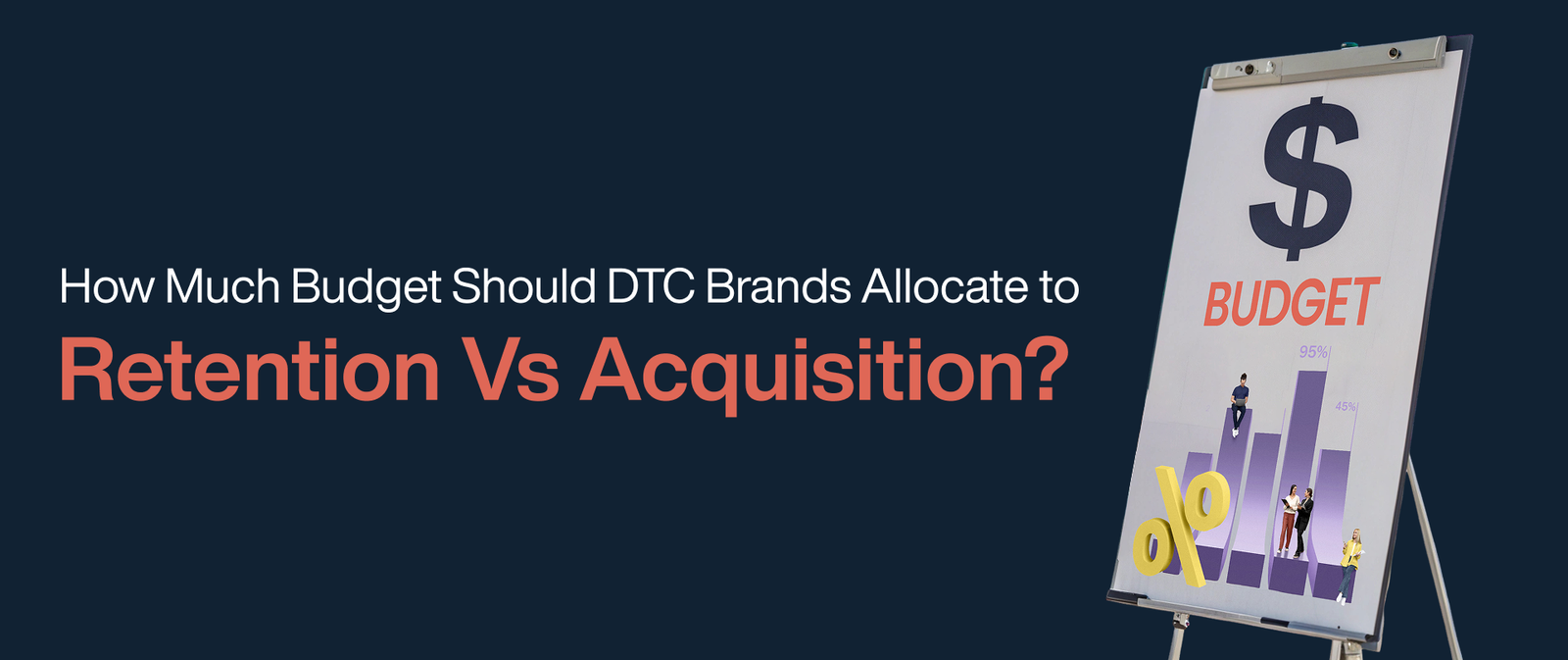How Much Budget Should DTC Brands Allocate to Retention vs Acquisition?

Balancing acquisition and retention is one of the most critical budgeting decisions for DTC brands. Too often, companies pour the majority of their spend into acquisition, only to realize that customer churn is eroding profits. On the other hand, prioritizing retention without fueling acquisition can limit growth. The truth is, sustainable scale requires a strategic balance.
In this blog, we will break down how to think about budget allocation between retention and acquisition, why the mix matters, and how leading DTC brands are optimizing their spending to maximize customer lifetime value and growth.
Why Budget Allocation Matters
Every dollar spent by a DTC brand has an opportunity cost. If the bulk of spend goes into acquisition, the brand may bring in more customers quickly but risk low retention and high churn. If too much emphasis is placed on retention, the business may nurture existing customers well but struggle to expand its market share.
For most brands, the challenge lies in finding the right allocation ratio between retention marketing and acquisition marketing. This decision impacts not just short-term sales but also long-term profitability, scalability, and valuation.
The True Cost of Acquisition
Acquisition is essential, but it is expensive. Customer acquisition costs (CAC) for DTC brands have steadily increased over the past few years due to rising competition, higher ad costs, and platform saturation. Meta and Google ads, once affordable channels, now often consume a large portion of marketing budgets with diminishing returns.
To put this into perspective:
- Many DTC brands now spend 5 to 7 times more to acquire a new customer than they do to retain an existing one.
- Studies consistently show that increasing customer retention by just 5% can lead to a 25% to 95% increase in profits.
The math is clear. While acquisition brings customers in, retention multiplies their value.
The Value of Retention
Retention marketing focuses on maximizing the value of each customer. It is about ensuring that customers who make a first purchase return for their second, third, and fourth purchase.
Retention is not only cheaper but also more predictable. Well-structured retention strategies stabilize revenue, build customer loyalty, and increase customer lifetime value (CLV). High CLV means higher margins, stronger cash flow, and a more resilient business.
Retention also creates compounding effects. Customers who stay longer tend to spend more, refer friends, and engage with your brand across multiple channels. This compounding growth cannot be replicated by acquisition alone.
How to Determine the Right Mix
There is no one-size-fits-all answer, but there are proven frameworks that DTC brands can follow.
1. Understand Your Current Metrics
Before allocating budget, assess:
- Current CAC (customer acquisition cost)
- Average CLV (customer lifetime value)
- Churn rate
- Payback period
These metrics will highlight whether you are overspending on acquisition without enough retention, or under-investing in acquisition and stunting growth.
2. Benchmark by Growth Stage
- Early-stage DTC brands: Typically spend 70-80% of their marketing budget on acquisition to build customer base, and 20-30% on retention to set foundations.
- Growth-stage brands: Often shift to a 50/50 split between acquisition and retention as they balance new customer growth with loyalty.
- Mature brands: Many profitable DTC leaders invest 60-70% in retention, while keeping 30-40% for efficient acquisition.
3. Calculate the Optimal Ratio
A common rule of thumb is to invest in retention until the marginal return on retention equals the marginal return on acquisition. If you are spending heavily on acquisition and CAC keeps rising while repeat purchases lag, it is a signal to reallocate more toward retention.
Practical Budget Allocation Framework
A practical framework DTC brands can adopt is the Retention-Weighted Growth Model:
- Allocate at least 30% of marketing budget to retention as a baseline.
- Measure retention ROI (email, SMS, loyalty programs, post-purchase flows) against acquisition ROI (ads, influencers, affiliates).
- Reallocate the budget quarterly based on ROI trends.
- Use retention channels to reduce CAC by warming leads (e.g., retargeting existing subscribers instead of cold audiences).
This ensures both sides of the funnel are supported, while prioritizing long-term CLV growth.
Real-World Example
Consider a DTC skincare brand:
- They initially spent 80% on acquisition and 20% on retention. While sales grew quickly, churn was over 60%.
- By reallocating to a 50/50 split, introducing retention strategies like personalized email flows, subscription models, and loyalty rewards, repeat purchase rates doubled.
- Within 12 months, revenue grew by 40% with lower overall ad spend.
The lesson is simple. Acquisition starts growth, but retention sustains and compounds it.
The Future of Budget Allocation for DTC Brands
Looking ahead, acquisition costs will likely continue to rise as ad platforms evolve and competition increases. Retention, however, will remain relatively cost-stable and scalable through owned channels.
The most successful DTC brands in the future will not be those who acquire the most customers but those who keep the most customers. This means retention marketing should be treated not as a secondary function but as a core growth driver.
Final Takeaway
So, how much budget should DTC brands allocate to retention vs acquisition?
- Early-stage brands: 70-80% acquisition, 20-30% retention
- Growth-stage brands: 50/50 split
- Mature brands: 60-70% retention, 30-40% acquisition
The key is not just to pick a ratio but to continually measure performance and adjust. Retention and acquisition are not competitors; they are partners in sustainable growth. The smartest brands will strike the balance that maximizes both CLV and market share.